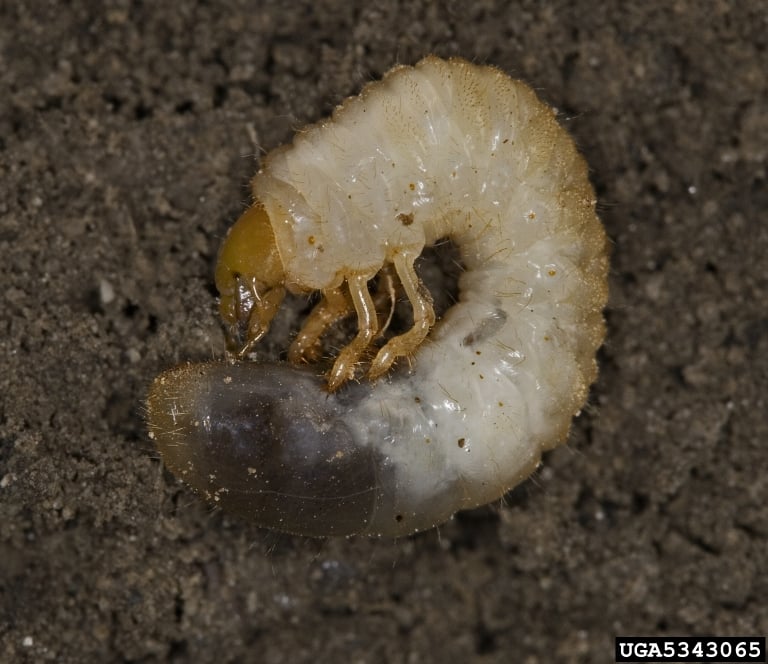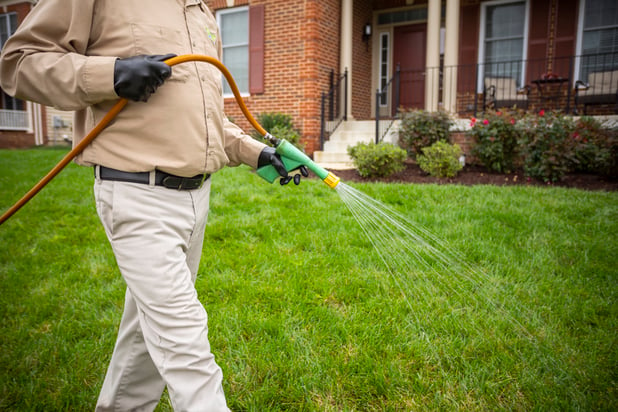5 Tips For Killing Grubs in Your Lawn in Central & Southern MD
Lawn grubs are not only gross, they are also sneaky.
Why? There’s no way you can really tell when they attack your lawn because they do their dirty work underground where you can’t see them.
In fact, your lawn can look just fine on the surface, but grubs are eating away at the lawn roots. And this cuts off the pathway of vital water or nutrients your lawn needs.
Pretty mean, right?
Since grubs can devastate your lawn in Central and Southern MD, let’s get to know these nasty pests and also review a few tips for killing grubs.
Killing Grubs Starts By Knowing the Enemy
Lawn grubs are pretty gross, we know.
 Grubs are technically the larvae of bugs like Japanese Beetles, European Chafers, Southern Masked Chafers, and June Beetles.
Grubs are technically the larvae of bugs like Japanese Beetles, European Chafers, Southern Masked Chafers, and June Beetles.
They are white and C-shaped with soft, squishy bodies and legs right beneath their heads.
And throughout their life cycles, they can actually damage your plants above and below ground.
Lawn Grubs & How They Feed
In spring, lawn grubs wake up from winter hibernation. They dig their way up from deep in the soil to just beneath the grass surface and begin to feed on your lawn’s root system. However, because the grass is vigorously growing in the spring, it’s unlikely that you’ll see damage.
Then, in late spring the larvae pupate in the ground and emerge in mid-summer as flying beetles. Some species like Japanese Beetles feed during the day and are obvious. However, some others only feed at night. It’s entirely possible to have a large infestation and not see them feeding on the leaves of your roses and crepe myrtles and other valued plants.
As the flying adults feed, they also mate and deposit eggs in lawn areas and even landscape beds. In late summer and early fall, their newly hatched grubs begin to feed on root systems. This is where major damage occurs as lawns cannot keep up with the damage as the hot, dry summer weather has already weakened it.
These suckers are hungry. A best-case scenario is there are a minimal amount of grubs that have been eating your lawn roots and your lawn may bounce back if it gets enough water. Think of a newly-laid piece of sod with no root system growing new roots and knitting itself to the soil again.
However, the worst-case (and most likely) scenario is you have dead patches of grass and once you try to control the grubs, you also have to aerate and overseed your lawn in the fall to boost its health and fill in the dead patches.
Clues You Might Have Grubs In Your Lawn
Not sure if grubs are present in your lawn? There are some telltale signs that you can look for.
- Is your lawn underperforming? Does it seem to be sluggishly growing in May, June and July? As the weather heats up and the lawn gets drier, you may even start to notice brown spots, which are dead patches of grass that no longer have roots that deliver water and nutrients to lawn plants.
- Notice raccoons, skunks and birds digging in your yard? Grubs are pretty tasty to these critters, so you’ll notice them looking for lunch in your lawn.
- Does your lawn look kind of loose? Grab a handful of our lawn and pull on it. If it rolls up like a loose carpet--meaning the lawn roots are no longer rooted--then you probably have grubs.
- Walk on your lawn. Does it feel spongy? This is another sign lawn grubs are feasting on your grass roots.
- When fall conditions are more ideal, is your lawn not turning green again in spots?
Tips for Killing Grubs in Your Lawn
So, you get the picture: Grubs are pretty nasty. Once they move in, they don’t leave. And their life cycles cause damage to multiple areas of the plant.
Now that you know something about lawn grubs, let’s talk about how you can keep them out of your lawn.
1. First, Understand That Nearly Everyone Has Grubs
Yes, unfortunately, nearly everyone has some grubs in their lawn.
The bigger question is: How many grubs do you have in your lawn? There are heavy years and light years of infestation based on the weather, as well as whether or not you’ve tried to control them at all. Mild winters, for instance, tend to cause heavier infestations of lawn grubs.
2. Timing is Everything With Grub Control
The key to grub control is to kill them in their early stages or even before they hatch so they don’t have a chance to cause serious damage to your lawn.
 So, prevention is your best bet. May and June is a great timeframe for early prevention of grubs.
So, prevention is your best bet. May and June is a great timeframe for early prevention of grubs.
3. DIY Grub Control Is Unpredictable
Do-it-yourself grub control can be successful, but you have to do everything right in the process.
Doing everything right means understanding the pest, its life cycle and what to look for. We gave you some of that knowledge above. Check.
Next, you have to know what product to purchase and how much to use based on the size of your lawn and level of infestation. This can get a little trickier. Do you know the square footage of your lawn and how many bags of product will cover it?
Next, you need a lawn spreader. And then you need to calibrate it properly so it spreads the product evenly throughout your lawn.
Finally, you have to apply a grub control product during the right time frame.
If you don’t get the right amount of product down at the right rate at the right time, it won’t be effective, and you may have wasted money. Plus, there are several active ingredients used in “grub control” formulations. Not all of the ones you’ll find at the garden store are the best options. Some of those are only available to the pros.
Use This Tool to Compare Your Local Lawn Care Companies
All this has to happen while you’re also juggling work, chores, family, etc.
4. Killing Grubs May Also Reduce the Animals That Dig Up Your Yard
People think that killing grubs will also get rid of your problems with moles, skunks, or birds digging up your lawn to go after their grub meal.
While this is a common belief, it’s not entirely fool-proof.
Yes, you may see fewer of these pests when you kill grubs in your lawn, but there’s no guarantee that solving one problem will eliminate the other.
5. Grub-Proof Lawns Take Planning
The best way to kill grubs is to choose a complete, proactive lawn care program.
 Natural Green Systems Lawn & Pest Control offers a grub solution that provides one-application, season-long control. This means it lasts all through summer and fall. We will also come back and inspect your lawn in the fall to ensure grubs haven’t returned if you see some signs that concern you.
Natural Green Systems Lawn & Pest Control offers a grub solution that provides one-application, season-long control. This means it lasts all through summer and fall. We will also come back and inspect your lawn in the fall to ensure grubs haven’t returned if you see some signs that concern you.
Plus, we offer other lawn care services, such as fertilization and weed control, that can enhance your lawn’s health and bring it back from any grub damage. While we’re on your property, we will continue to monitor for grubs to make sure they stay away.
Grub control can be an add-on service that costs approximately $150 for a 5,000-square-foot lawn. But grub control also comes with other lawn care services in our Lawn Builder Elite program at a discount.
Want to Kick Grubs to the Curb? Trust Natural Green
Grubs gobbling your grass roots is not a problem you want at the top of your to-do list. You have enough things to think about.
Natural Green would love to create a custom lawn care plan for you to ensure your yard thrives, while also killing any grubs and reviving your lawn.
Ready to stop the grub madness in your Central and Southern Maryland lawn? Request a free quote today. We’ll review our options together so you can make the best choice for you. Then you can sit back and enjoy your yard--worry free!
Image sources: grub in soil
Lawn grubs are not only gross, they are also sneaky.
Why? There’s no way you can really tell when they attack your lawn because they do their dirty work underground where you can’t see them.
In fact, your lawn can look just fine on the surface, but grubs are eating away at the lawn roots. And this cuts off the pathway of vital water or nutrients your lawn needs.
Pretty mean, right?
Since grubs can devastate your lawn in Central and Southern MD, let’s get to know these nasty pests and also review a few tips for killing grubs.
Killing Grubs Starts By Knowing the Enemy
Lawn grubs are pretty gross, we know.
 Grubs are technically the larvae of bugs like Japanese Beetles, European Chafers, Southern Masked Chafers, and June Beetles.
Grubs are technically the larvae of bugs like Japanese Beetles, European Chafers, Southern Masked Chafers, and June Beetles.
They are white and C-shaped with soft, squishy bodies and legs right beneath their heads.
And throughout their life cycles, they can actually damage your plants above and below ground.
Lawn Grubs & How They Feed
In spring, lawn grubs wake up from winter hibernation. They dig their way up from deep in the soil to just beneath the grass surface and begin to feed on your lawn’s root system. However, because the grass is vigorously growing in the spring, it’s unlikely that you’ll see damage.
Then, in late spring the larvae pupate in the ground and emerge in mid-summer as flying beetles. Some species like Japanese Beetles feed during the day and are obvious. However, some others only feed at night. It’s entirely possible to have a large infestation and not see them feeding on the leaves of your roses and crepe myrtles and other valued plants.
As the flying adults feed, they also mate and deposit eggs in lawn areas and even landscape beds. In late summer and early fall, their newly hatched grubs begin to feed on root systems. This is where major damage occurs as lawns cannot keep up with the damage as the hot, dry summer weather has already weakened it.
These suckers are hungry. A best-case scenario is there are a minimal amount of grubs that have been eating your lawn roots and your lawn may bounce back if it gets enough water. Think of a newly-laid piece of sod with no root system growing new roots and knitting itself to the soil again.
However, the worst-case (and most likely) scenario is you have dead patches of grass and once you try to control the grubs, you also have to aerate and overseed your lawn in the fall to boost its health and fill in the dead patches.
Clues You Might Have Grubs In Your Lawn
Not sure if grubs are present in your lawn? There are some telltale signs that you can look for.
- Is your lawn underperforming? Does it seem to be sluggishly growing in May, June and July? As the weather heats up and the lawn gets drier, you may even start to notice brown spots, which are dead patches of grass that no longer have roots that deliver water and nutrients to lawn plants.
- Notice raccoons, skunks and birds digging in your yard? Grubs are pretty tasty to these critters, so you’ll notice them looking for lunch in your lawn.
- Does your lawn look kind of loose? Grab a handful of our lawn and pull on it. If it rolls up like a loose carpet--meaning the lawn roots are no longer rooted--then you probably have grubs.
- Walk on your lawn. Does it feel spongy? This is another sign lawn grubs are feasting on your grass roots.
- When fall conditions are more ideal, is your lawn not turning green again in spots?
Tips for Killing Grubs in Your Lawn
So, you get the picture: Grubs are pretty nasty. Once they move in, they don’t leave. And their life cycles cause damage to multiple areas of the plant.
Now that you know something about lawn grubs, let’s talk about how you can keep them out of your lawn.
1. First, Understand That Nearly Everyone Has Grubs
Yes, unfortunately, nearly everyone has some grubs in their lawn.
The bigger question is: How many grubs do you have in your lawn? There are heavy years and light years of infestation based on the weather, as well as whether or not you’ve tried to control them at all. Mild winters, for instance, tend to cause heavier infestations of lawn grubs.
2. Timing is Everything With Grub Control
The key to grub control is to kill them in their early stages or even before they hatch so they don’t have a chance to cause serious damage to your lawn.
 So, prevention is your best bet. May and June is a great timeframe for early prevention of grubs.
So, prevention is your best bet. May and June is a great timeframe for early prevention of grubs.
3. DIY Grub Control Is Unpredictable
Do-it-yourself grub control can be successful, but you have to do everything right in the process.
Doing everything right means understanding the pest, its life cycle and what to look for. We gave you some of that knowledge above. Check.
Next, you have to know what product to purchase and how much to use based on the size of your lawn and level of infestation. This can get a little trickier. Do you know the square footage of your lawn and how many bags of product will cover it?
Next, you need a lawn spreader. And then you need to calibrate it properly so it spreads the product evenly throughout your lawn.
Finally, you have to apply a grub control product during the right time frame.
If you don’t get the right amount of product down at the right rate at the right time, it won’t be effective, and you may have wasted money. Plus, there are several active ingredients used in “grub control” formulations. Not all of the ones you’ll find at the garden store are the best options. Some of those are only available to the pros.
Use This Tool to Compare Your Local Lawn Care Companies
All this has to happen while you’re also juggling work, chores, family, etc.
4. Killing Grubs May Also Reduce the Animals That Dig Up Your Yard
People think that killing grubs will also get rid of your problems with moles, skunks, or birds digging up your lawn to go after their grub meal.
While this is a common belief, it’s not entirely fool-proof.
Yes, you may see fewer of these pests when you kill grubs in your lawn, but there’s no guarantee that solving one problem will eliminate the other.
5. Grub-Proof Lawns Take Planning
The best way to kill grubs is to choose a complete, proactive lawn care program.
 Natural Green Systems Lawn & Pest Control offers a grub solution that provides one-application, season-long control. This means it lasts all through summer and fall. We will also come back and inspect your lawn in the fall to ensure grubs haven’t returned if you see some signs that concern you.
Natural Green Systems Lawn & Pest Control offers a grub solution that provides one-application, season-long control. This means it lasts all through summer and fall. We will also come back and inspect your lawn in the fall to ensure grubs haven’t returned if you see some signs that concern you.
Plus, we offer other lawn care services, such as fertilization and weed control, that can enhance your lawn’s health and bring it back from any grub damage. While we’re on your property, we will continue to monitor for grubs to make sure they stay away.
Grub control can be an add-on service that costs approximately $150 for a 5,000-square-foot lawn. But grub control also comes with other lawn care services in our Lawn Builder Elite program at a discount.
Want to Kick Grubs to the Curb? Trust Natural Green
Grubs gobbling your grass roots is not a problem you want at the top of your to-do list. You have enough things to think about.
Natural Green would love to create a custom lawn care plan for you to ensure your yard thrives, while also killing any grubs and reviving your lawn.
Ready to stop the grub madness in your Central and Southern Maryland lawn? Request a free quote today. We’ll review our options together so you can make the best choice for you. Then you can sit back and enjoy your yard--worry free!
Image sources: grub in soil
Share This
Topics: Lawn Care


